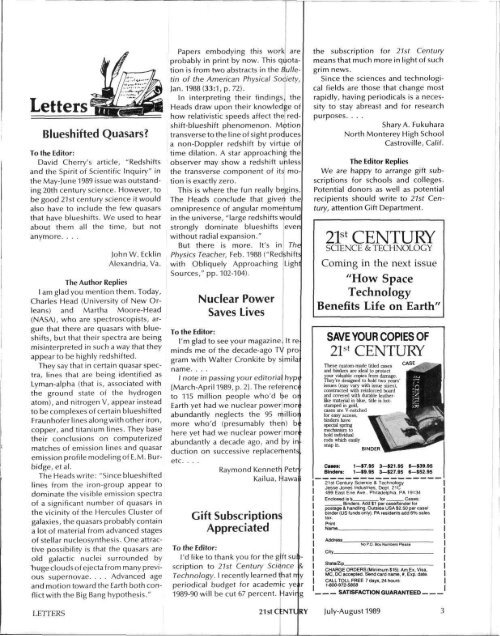Brunelleschi's Dome
Brunelleschi's Dome
Brunelleschi's Dome
Create successful ePaper yourself
Turn your PDF publications into a flip-book with our unique Google optimized e-Paper software.
Letters<br />
Blueshifted Quasars?<br />
To the Editor:<br />
David Cherry's article, "Redshifts<br />
and the Spirit of Scientific Inquiry" in<br />
the May-June 1989 issue was outstanding<br />
20th century science. However, to<br />
be good 21st century science it would<br />
also have to include the few quasars<br />
that have blueshifts. We used to hear<br />
about them all the time, but not<br />
anymore. . . .<br />
JohnW. Ecklin<br />
Alexandria, Va.<br />
The Author Replies<br />
I am glad you mention them. Today,<br />
Charles Head (University of New Orleans)<br />
and Martha Moore-Head<br />
(NASA), who are spectroscopists, argue<br />
that there are quasars with blueshifts,<br />
but that their spectra are being<br />
misinterpreted in such a way that they<br />
appear to be highly redshifted.<br />
They say that in certain quasar spectra,<br />
lines that are being identified as<br />
Lyman-alpha (that is, associated with<br />
the ground state of the hydrogen<br />
atom), and nitrogen V, appear instead<br />
to be complexes of certain blueshifted<br />
Fraunhofer lines along with other iron,<br />
copper, and titanium lines. They base<br />
their conclusions on computerized<br />
matches of emission lines and quasar<br />
emission profile modeling of E.M. Burbidge,<br />
etal.<br />
The Heads write: "Since blueshifted<br />
lines from the iron-group appear to<br />
dominate the visible emission spectra<br />
of a significant number of quasars in<br />
the vicinity of the Hercules Cluster of<br />
galaxies, the quasars probably contain<br />
a lot of material from advanced stages<br />
of stellar nucleosynthesis. One attractive<br />
possibility is that the quasars are<br />
old galactic nuclei surrounded by<br />
"huge clouds of ejecta from many previous<br />
supernovae. . . . Advanced age<br />
and motion toward the Earth both conflict<br />
with the Big Bang hypothesis."<br />
Papers embodying this work are<br />
probably in print by now. This quotation<br />
is from two abstracts in the Bulletin<br />
of the American Physical Society,<br />
Jan. 1988 (33:1, p. 72).<br />
In interpreting their findings, the<br />
Heads draw upon their knowledge of<br />
how relativistic speeds affect the redshift-blueshift<br />
phenomenon. Motion<br />
transverse to the line of sight produces<br />
a non-Doppler redshift by virtue of<br />
time dilation. A star approaching the<br />
observer may show a redshift unless<br />
the transverse component of its mo<br />
tion is exactly zero.<br />
This is where the fun really begins.<br />
The Heads conclude that given the<br />
omnipresence of angular momentum<br />
in the universe, "large redshifts would<br />
strongly dominate blueshifts even<br />
without radial expansion."<br />
But there is more. It's in The<br />
Physics Teacher, Feb. 1988 ("Redshifts<br />
with Obliquely Approaching Light<br />
Sources," pp. 102-104).<br />
Nuclear Power<br />
Saves Lives<br />
To the Editor:<br />
I'm glad to see your magazine. It re<br />
minds me of the decade-ago TV pro<br />
gram with Walter Cronkite by simila<br />
name. . . .<br />
I note in passing your editorial hyp<<br />
[March-April 1989, p. 2]. The reference<br />
to 115 million people who'd be or<br />
Earth yet had we nuclear power mon<br />
abundantly neglects the 95 millior<br />
more who'd (presumably then) be<br />
here yet had we nuclear power mon <<br />
abundantly a decade ago, and by in<br />
duction on successive replacements,<br />
etc. . . .<br />
Raymond Kenneth Petr<br />
Kailua, Hawa<br />
Gift Subscriptions<br />
Appreciated<br />
To the Editor:<br />
I'd like to thank you for the gift sul i<br />
scription to 21st Century Science &<br />
Technology. I recently learned that rr y<br />
periodical budget for academic ye \r<br />
1989-90 will be cut 67 percent. Havir g<br />
the subscription for 21st Century<br />
means that much more in light of such<br />
grim news.<br />
Since the sciences and technological<br />
fields are those that change most<br />
rapidly, having periodicals is a necessity<br />
to stay abreast and for research<br />
purposes. . . .<br />
Shary A. Fukuhara<br />
North Monterey High School<br />
Castroville, Calif.<br />
The Editor Replies<br />
We are happy to arrange gift subscriptions<br />
for schools and colleges.<br />
Potential donors as well as potential<br />
recipients should write to 27st Century,<br />
attention Gift Department.<br />
21 st CENTURY<br />
SCIENCE & TECHNOLOGY<br />
Coming in the next issue<br />
"How Space<br />
Technology<br />
Benefits Life on Earth"<br />
LETTERS<br />
21stCENTLRY July-August 1989

















